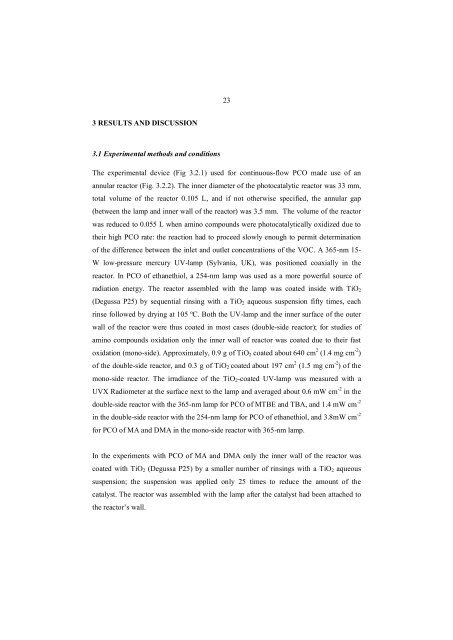gas-phase photocatalytic oxidation of volatile organic ... - Doria
gas-phase photocatalytic oxidation of volatile organic ... - Doria
gas-phase photocatalytic oxidation of volatile organic ... - Doria
You also want an ePaper? Increase the reach of your titles
YUMPU automatically turns print PDFs into web optimized ePapers that Google loves.
3 RESULTS AND DISCUSSION<br />
3.1 Experimental methods and conditions<br />
23<br />
The experimental device (Fig 3.2.1) used for continuous-flow PCO made use <strong>of</strong> an<br />
annular reactor (Fig. 3.2.2). The inner diameter <strong>of</strong> the <strong>photocatalytic</strong> reactor was 33 mm,<br />
total volume <strong>of</strong> the reactor 0.105 L, and if not otherwise specified, the annular gap<br />
(between the lamp and inner wall <strong>of</strong> the reactor) was 3.5 mm. The volume <strong>of</strong> the reactor<br />
was reduced to 0.055 L when amino compounds were <strong>photocatalytic</strong>ally oxidized due to<br />
their high PCO rate: the reaction had to proceed slowly enough to permit determination<br />
<strong>of</strong> the difference between the inlet and outlet concentrations <strong>of</strong> the VOC. A 365-nm 15-<br />
W low-pressure mercury UV-lamp (Sylvania, UK), was positioned coaxially in the<br />
reactor. In PCO <strong>of</strong> ethanethiol, a 254-nm lamp was used as a more powerful source <strong>of</strong><br />
radiation energy. The reactor assembled with the lamp was coated inside with TiO2<br />
(Degussa P25) by sequential rinsing with a TiO2 aqueous suspension fifty times, each<br />
rinse followed by drying at 105 ºC. Both the UV-lamp and the inner surface <strong>of</strong> the outer<br />
wall <strong>of</strong> the reactor were thus coated in most cases (double-side reactor); for studies <strong>of</strong><br />
amino compounds <strong>oxidation</strong> only the inner wall <strong>of</strong> reactor was coated due to their fast<br />
<strong>oxidation</strong> (mono-side). Approximately, 0.9 g <strong>of</strong> TiO2 coated about 640 cm 2 (1.4 mg cm -2 )<br />
<strong>of</strong> the double-side reactor, and 0.3 g <strong>of</strong> TiO2 coated about 197 cm 2 (1.5 mg cm -2 ) <strong>of</strong> the<br />
mono-side reactor. The irradiance <strong>of</strong> the TiO2-coated UV-lamp was measured with a<br />
UVX Radiometer at the surface next to the lamp and averaged about 0.6 mW cm -2 in the<br />
double-side reactor with the 365-nm lamp for PCO <strong>of</strong> MTBE and TBA, and 1.4 mW cm -2<br />
in the double-side reactor with the 254-nm lamp for PCO <strong>of</strong> ethanethiol, and 3.8mW cm -2<br />
for PCO <strong>of</strong> MA and DMA in the mono-side reactor with 365-nm lamp.<br />
In the experiments with PCO <strong>of</strong> MA and DMA only the inner wall <strong>of</strong> the reactor was<br />
coated with TiO2 (Degussa P25) by a smaller number <strong>of</strong> rinsings with a TiO2 aqueous<br />
suspension; the suspension was applied only 25 times to reduce the amount <strong>of</strong> the<br />
catalyst. The reactor was assembled with the lamp after the catalyst had been attached to<br />
the reactor’s wall.

















